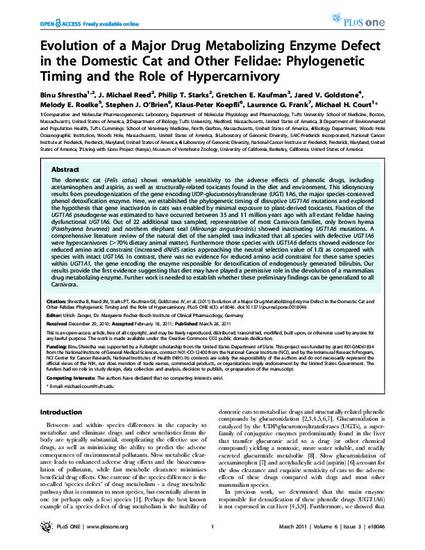
The domestic cat (Felis catus) shows remarkable sensitivity to the adverse effects of phenolic drugs, including acetaminophen and aspirin, as well as structurally-related toxicants found in the diet and environment. This idiosyncrasy results from pseudogenization of the gene encoding UDP-glucuronosyltransferase (UGT) 1A6, the major species-conserved phenol detoxification enzyme. Here, we established the phylogenetic timing of disruptive UGT1A6 mutations and explored the hypothesis that gene inactivation in cats was enabled by minimal exposure to plant-derived toxicants. Fixation of the UGT1A6 pseudogene was estimated to have occurred between 35 and 11 million years ago with all extant Felidae having dysfunctional UGT1A6. Out of 22 additional taxa sampled, representative of most Carnivora families, only brown hyena (Parahyaena brunnea) and northern elephant seal (Mirounga angustirostris) showed inactivating UGT1A6 mutations. A comprehensive literature review of the natural diet of the sampled taxa indicated that all species with defective UGT1A6 were hypercarnivores (>70% dietary animal matter). Furthermore those species with UGT1A6 defects showed evidence for reduced amino acid constraint (increased dN/dS ratios approaching the neutral selection value of 1.0) as compared with species with intact UGT1A6. In contrast, there was no evidence for reduced amino acid constraint for these same species within UGT1A1, the gene encoding the enzyme responsible for detoxification of endogenously generated bilirubin. Our results provide the first evidence suggesting that diet may have played a permissive role in the devolution of a mammalian drug metabolizing enzyme. Further work is needed to establish whether these preliminary findings can be generalized to all Carnivora.
Available at: http://works.bepress.com/stephen-obrien/237/

This is an open-access article, free of all copyright, and may be freely reproduced, distributed, transmitted, modified, built upon, or otherwise used by anyone for any lawful purpose. The work is made available under the Creative Commons CC0 public domain dedication.